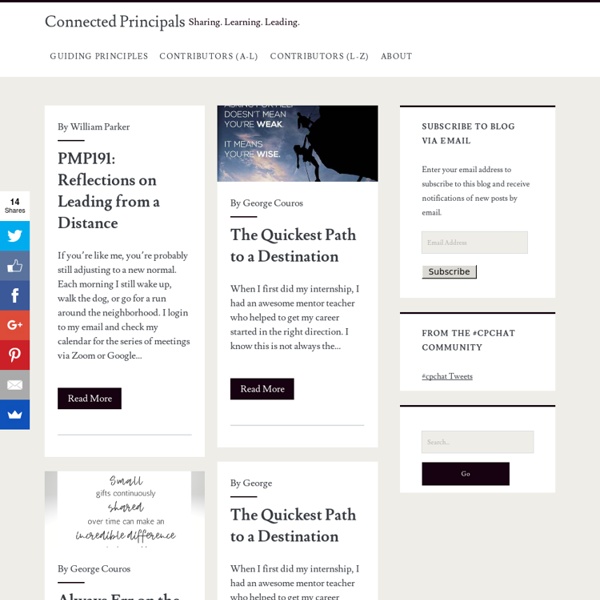Chris Lehmann: Practical Theory
[This year marked the first graduating class of our second campus – SLA@Beeber. I was honored and thrilled to be asked to be the keynote speaker. It’s been such an incredible experience to watch this group of students and families and educators build this school into something wonderful, and I was so excited to share the day with them. — Chris] To the Science Leadership Academy @ Beeber inaugural class – the Class of 2017 – congratulations! I cannot begin to tell you how much it means to me to be standing in front of you today.
Education Database Online Blog
Is Apple Still a Game Changer in Education? The words "Apple" and "innovation" often go hand in hand, but the tech giant has been less dominant in education than it has been in other areas. While the iPad has continued to change the way many classrooms function, Apple's once-leading online education platform, iTunes U, is now left out of most discussions about online learning and OpenCourseWare.
Technology tools to use in the foreign language classroom
Now that you have set goals to integrate technology in the foreign language classroom (if not make sure you do, as that is the first step you should take to to use technology in your class), it’s time to find out which technology tools are the best for your purpose. My advice for choosing a technology tool for your classroom is to start simple! Even if you feel very comfortable with technology, it is a good idea to choose a simple one to start with. Why?
Evolving Schools for a Whole New Mind
Today I have been at Munich International School listening to the keynote from Dan Pink. This was a great start to the conference. Dan started with a quote from Dr Richard Moniuszko: We need to prepare kids for their future, not our past.
2011 Lesson #1 – Vision has to trump administration
The Zone, a renovated workspace at NBCS 2011 2011 has been an amazing year for me professionally – a year of great change at NBCS and a year of outstanding opportunities, travel and thinking for me. It has also been a year of new connections. I am going to try and capture some of the main insights during 2011 gained in a sequence of blogs. 2011 Lesson #1 – Vision has to trump administration One of my recent trips was to speak at and attend the Virtual School Symposium in Indianapolis.
Partnering with Your Principal
When you’re a school librarian, there are a few people in your building that you need to ally with immediately. First, befriend the bookkeeper who will make spending your limited budget stress-free. Keep the custodians on your side so they’ll still be smiling after your classes make 3-D cloud models with cotton balls and a lot of glue. And, of course, you want your administrator to be a prominent member of the “Our Library Rocks” club. Smiles, properly submitted quotes for purchase orders, and a batch of “I’m sorry” chocolate chip cookies go a long way to cement some alliances, but it takes something different to create a productive partnership with your principal. I’ve been fortunate to work with very supportive administrators throughout my teaching career.
Tips for First Year Principals: Eight Ways to Make Your Mark
By Carol D. Birks With Judith Richardson Since becoming the principal of Warren Harding High School in Bridgeport, CT in July 2007, I have worked tirelessly to begin a four-pronged partnership of accountability to move Warren Harding High School on a path of continuous improvement. The partnership relies on the cooperation and commitment of faculty members, students, parents and the community. A theory of action for my first year emerged from the one-to-one interviews and focus groups with all stakeholders that I conducted soon after my appointment. The fundamental collaboration of all stakeholders has been the driving force behind the school’s successes.
Better Beginnings: how to start a presentation, book, article...
« Dilbert and the zone of mediocrity | Main | Why does engineering/math/science education in the US suck? » Better Beginnings: how to start a presentation, book, article... You are in a dimly lit room. You are alone on a stage before an audience of 1,000. 10 minutes into your presentation, your hands no longer shake or sweat. This is going well, you think.
18 Steps to Better Educational Innovation Leadership: Advice from Christensen’s Innovator’s DNA
Heidi Hayes Jacobs: ”If you’re not updating your curriculum, you are saying that nothing is changing.” “Nearly two-thirds (63 percent) of school administrators who responded to a recent survey said 1:1 computing classrooms where teachers act as a coach for students are the future of education.” ( T.H.E Journal) “Innovative teaching supports students’ development of the skills that will help them thrive in future life and work.” ( ITL Research) One of the most exciting books of the year for those of us seeking to become ever more effective as innovative school-leaders and leaders of innovative schools, and, even more importantly, seeking to facilitate our students’ development of more innovative mindsets, is the new book from Clayton Christensen (et.al), The Innovator’s DNA: Mastering the 5 Skills of Disruptive Innovators .


